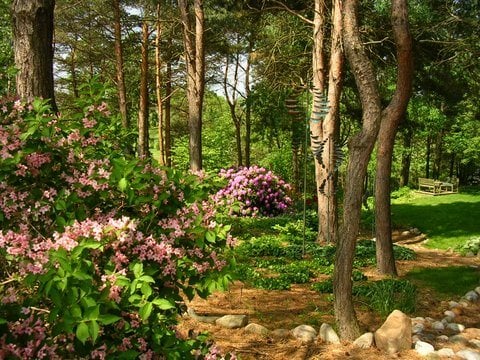My Garden: An Overgrown Hillside Becomes a Wooded Wonderland
Some of the most delightful gardens are those that come together haphazardly, with no particular plan in mind. Instead, they are the result of hard work, a good deal of trial and error, and immense patience.

Azaleas and rhododendrons bloom along a wood-chip path, under a canopy of tall pine trees. (Photo by: Hugh Stephens)
When Chicago artist Hugh Stephens retired years ago and acquired this 25-acre hillside property in a rural area outside Fennville, Michigan, the landscape consisted of overgrown yew hedges, rampant patches of poison ivy, and dead and dying pine trees. Having little gardening experience and no idea of what to do with such a vast amount of space, he simply started out with a few flats of annuals and took it from there. “Because I'd lived in the city most of my life, there was no particular design for the property, so what resulted was a learn-as-you-go-along style of gardening,” he says.
Stephens was helped in his efforts by partner Jim Nulty, who moved from Indianapolis several years ago to join him. One thing lead to another, and they started by removing trees to create sunny spaces where plants would thrive and clearing shady spots of poison ivy to make room for lush fern and hosta gardens.

Hostas come up among spent daffodils, and will soon fill in the spots occupied by the wilting foliage. (Photo by: Hugh Stephens)
They also reshaped a slope by moving large rocks, which opened up the opportunity for a rock garden. A field in front of the home was turned into a labyrinth, with strategically mowed paths providing a contemplative 15 minute walk for visitors. Wood-mulched trails edged with rocks and fallen tree branches guide visitors through the maze.

Cast concrete garden markers along the intersections of mulched trails lead to gardens of mixed perennials, annuals, and bulbs. (Photo by: Hugh Stephens)
In contrast to the shady wooded areas, the upper level of the property is open to abundant sunshine. Located there is a large patch of native prairie, a vegetable garden fenced against deer, and three circular gardens of perennials and annuals edged with wine bottles half buried in the ground. “As a weekend volunteer in prairie restoration with the Nature Conservancy in Chicago, I got interested in native grasses, so one of the first things I got started on was a small prairie in a sunny spot behind the house,” says Stephens.

Native grasses in the prairie garden become brilliant waves of gold in the fall. (Photo by: Hugh Stephens)
The landscaping style, if there is one, might be called eclectic. “We don't have any particular favorite plants, and each year something new attracts our attention,” says Stephens. “One year it's euphorbias, another it's hellebores and then amsonias, bonsai, and orchids. We've added Star Gazer lilies and Nicotiana sylvestris next to the screen porch for beautiful scent in the evening. We don't keep records of the cultivars we have, and our dog is an expert at snatching plant tags, so we just enjoy what’s here.”

Strategically placed wooden decks with benches throughout the gardens provide spots for visitors (and the family dog) to relax and enjoy the view. (Photo by: Hugh Stephens)
Today the property is a well-orchestrated blend of woodlands, prairie, and manicured gardens, offering opportunities for discovery at every turn. “Because we do all the work on the gardens ourselves, we should be planning to make them smaller as we age. But like all gardeners, we tend to edge out a little farther each year and add beds in new sunny areas created when dead trees are removed. We can't resist making use of any new space that presents itself,” Stephens says.
See more reader gardens here

The garden is particularly glorious in early spring, when daffodils and spring ephemerals begin blooming before the trees leaf out. Bloodroot, trillium, Dutchman’s Breeches, wild ginger, azaleas, Solomon’s Seal, and twinleaf abound. The soil is perfect for rhododendrons, and many grow as tall as 20 feet high. (Photo by: Hugh Stephens)

Hollyhocks bloom next to a homemade tower. (Photo by: Hugh Stephens)

A covered gazebo offers a shady spot for morning coffee before the gardening begins and a restful spot for a well-deserved glass of wine at day’s end. (Photo by: Hugh Stephens)

